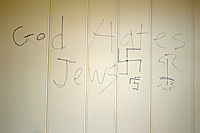By Morris Malakoff, JTNews Correspondent
While the physical damage was minor, the psychological impact of an act of anti-Semitic vandalism at one area congregation was huge.
When members of Vashon Island’s Havurat Ee Shalom arrived at their synagogue on the morning of July 19 for a Torah study group, they discovered a broken window and a wall inside scrawled with swastikas and the words “God hates Jews.”
Congregation files had been rifled, but valuable sacred objects such as the ark went untouched.
“I don’t think whoever did this had any idea what that was,” said congregation president Louise Olsen.
For both members of the small congregation and the larger community, the act was not only shocking, but what Havurat Ee Shalom founding member Emma Amiad terms “a wake up call.”
“We are a small and insular community,” Amiad said. “We like to think that something like this could not happen here. They have made it clear that there is an attitude in the community of ‘not on our island.’”
While repairing the broken window and painting over the malicious graffiti was quick and easy, repairing the communal pain has become a long-term effort embraced by people of many faiths on the island.
“I am gratified by the response of our community,” Olsen said. “They too, were genuinely appalled by this act.”
While the community reaction was swift and supportive, there was a feeling that concern was not shared by local law enforcement, which is provided by the King County Sheriff.
“I don’t think it is an issue specific to this particular crime,” Amiad said. “We are part of the precinct that includes the White Center area and a deputy being sent over here is seen as one being sent for a little ‘R and R.’”
When the deputy responding to the vandalism seemed somewhat indifferent to the nature of the crime, Havurat Ee Shalom member and attorney Matt Bergman contacted the King County Prosecutor’s Office. He made it clear that this was more than an act of random vandalism and that it met the definition of a federal hate crime.
Within hours, a deputy prosecutor and a sheriff’s detective were assigned to the case.
Amiad and Olsen both said that while the evidence points to the attack likely being perpetrated by, as Amiad characterized it, ‘disaffected youths,’ they agreed that steps must be taken to prevent it from becoming something more sinister.
“While I don’t want to overdramatize the incident, the fact is, this is how larger problems begin,” Amiad said.
Olsen said that there have been a few other minor acts of vandalism against other religious communities on the island during the past year, but nothing that has shown a pattern of hate crime-type behaviors. A safe from the Catholic Church was stolen and later found by divers in waters off the island. Then, there was the smashing of a treasured stained glass window in a Presbyterian church. The vandals in that act were caught, but the parishioners declined to press charges.
This time, those caught are not likely to be looked upon with a similar measure of mercy.
“I believe that there is a sense that we want to see this fully prosecuted as a hate crime,” Amiad said.
The reaction by the greater community to the latest incident has been reassuring to the members of Havurat Ee Shalom. The Vashon community quickly began to gather funds to help pay for repair of the damage. While that support was initially aimed at repairing a window and painting over the hate message, it appears it will also go toward two types of prevention: physical and educational.
The congregation board was scheduled to meet earlier this week to take action on expenditure of the funds and to look at a longer-term plan of action.
After paying the costs of repairing the damage from the attack and equipping the building used by the congregation with an alarm system, plans include funding a reward to help identify those who broke into Havurat Ee Shalom and helping to fund a tolerance education program in the local schools.
The communal healing process began with a vigil held on Aug. 1 at an intersection in the town of Vashon. It is a corner that is considered the gathering place for the largely rural island.
“There were about 150 people there, carrying signs of support, speaking out against intolerance in the community,” Amiad said. “But it was Matt Bergman who really put it into perspective for everyone.”
“He told the community that they did not have to be there,” she said. “He told them that by showing they were not fearful and would stand up for others in the community they would make a difference. He told them that if others had done the same decades ago, we would not have had a Holocaust.”
